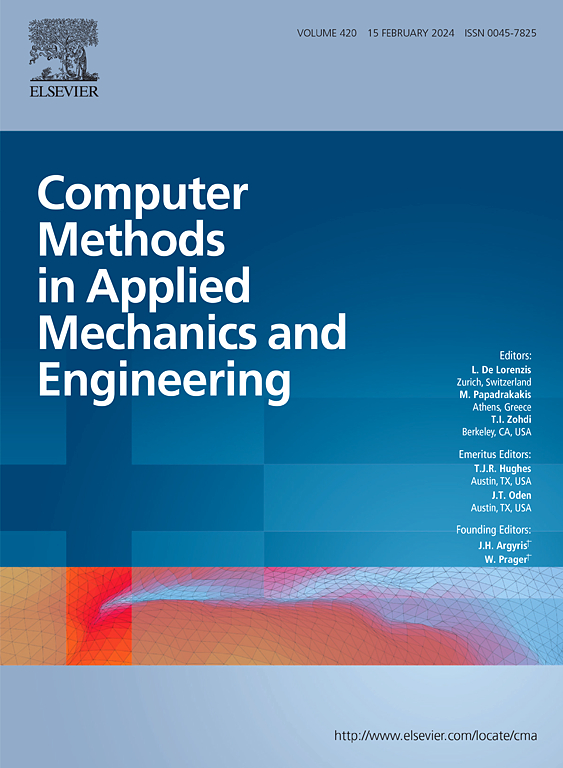A phase-field length scale insensitive micropolar fatigue model
IF 7.3
1区 工程技术
Q1 ENGINEERING, MULTIDISCIPLINARY
Computer Methods in Applied Mechanics and Engineering
Pub Date : 2025-07-28
DOI:10.1016/j.cma.2025.118259
引用次数: 0
Abstract
This article proposes a novel micropolar phase-field model for size-dependent fatigue failure in solids under mechanical loading. To develop the proposed model that can capture experimentally observed size effects in brittle materials, we employ micropolar theory in a phase-field length scale-insensitive framework and address the limitations of classical phase-field fatigue models. A key advantage of the proposed model is its ability to eliminate artificial nonlocal effects introduced by the phase field length scale while preserving the physical size effects dictated by the material microstructure. In the proposed model, we introduce micro-rotation as an additional kinematic variable and derive the governing partial differential equations by invoking the principle of virtual power. The constitutive relations are established in accordance with thermodynamic laws, enabling the incorporation of dissipative effects whenever required. To make the proposed model insensitive to the phase-field length scale and thus eliminate artificial nonlocal effects, we incorporate a fatigue-related parameter that defines the fatigue threshold energy as a function of the material fracture strength. We demonstrate the efficacy of the proposed model through numerical simulations on a set of benchmark two- and three-dimensional problems that include three-point bending tests, single-edge notched plates, etc., and provide a qualitative experimental validation against the results available in the literature. The numerical results show a significant influence of the micropolar parameters on fatigue behavior, emphasizing the necessity of the proposed formulation for materials that exhibit pronounced nonlocal effects. We demonstrate the insensitivity of the proposed model to the phase-field length scale using plots of consistent crack growth versus the number of cycles for different values of the phase-field length scale. For the numerical implementation of the proposed model, we use an open-source finite element library called Gridap, available in Julia, a recently developed high-performance programming language. The availability of open-source codes ensures transparency, reproducibility, and ease of verification, setting a high standard for open-source computational tools in scientific research. The numerical findings validate the robustness of the proposed model, establishing its suitability for accurately simulating size-dependent fatigue behavior in materials.

相场长度尺度不敏感的微极性疲劳模型
本文提出了一种新的微极性相场模型,用于研究固体在机械载荷作用下的尺寸相关疲劳失效。为了开发能够捕获脆性材料中实验观察到的尺寸效应的拟议模型,我们在相场长度尺度不敏感框架中采用微极性理论,并解决经典相场疲劳模型的局限性。该模型的一个关键优点是能够消除由相场长度尺度引入的人为非局部效应,同时保留由材料微观结构决定的物理尺寸效应。在该模型中,我们引入微旋转作为附加的运动学变量,并利用虚功率原理推导出控制偏微分方程。本构关系是根据热力学定律建立的,可以在需要时将耗散效应纳入其中。为了使所提出的模型对相场长度尺度不敏感,从而消除人为的非局部影响,我们纳入了一个疲劳相关参数,该参数将疲劳阈值能量定义为材料断裂强度的函数。我们通过对一组基准二维和三维问题(包括三点弯曲测试、单边缺口板等)的数值模拟证明了所提出模型的有效性,并针对文献中的结果提供了定性实验验证。数值结果表明微极性参数对疲劳行为有显著的影响,强调了对于具有明显非局部效应的材料所提出的公式的必要性。我们使用一致裂纹扩展与不同相场长度尺度的循环次数的图来证明所提出的模型对相场长度尺度的不敏感性。对于所提出的模型的数值实现,我们使用了一个名为Gridap的开源有限元库,该库可在最近开发的高性能编程语言Julia中使用。开放源代码的可用性确保了透明度、可重复性和易于验证,为科学研究中的开放源代码计算工具设定了高标准。数值结果验证了该模型的鲁棒性,建立了其准确模拟材料尺寸相关疲劳行为的适用性。
本文章由计算机程序翻译,如有差异,请以英文原文为准。
求助全文
约1分钟内获得全文
求助全文
来源期刊
CiteScore
12.70
自引率
15.30%
发文量
719
审稿时长
44 days
期刊介绍:
Computer Methods in Applied Mechanics and Engineering stands as a cornerstone in the realm of computational science and engineering. With a history spanning over five decades, the journal has been a key platform for disseminating papers on advanced mathematical modeling and numerical solutions. Interdisciplinary in nature, these contributions encompass mechanics, mathematics, computer science, and various scientific disciplines. The journal welcomes a broad range of computational methods addressing the simulation, analysis, and design of complex physical problems, making it a vital resource for researchers in the field.

 求助内容:
求助内容: 应助结果提醒方式:
应助结果提醒方式:


